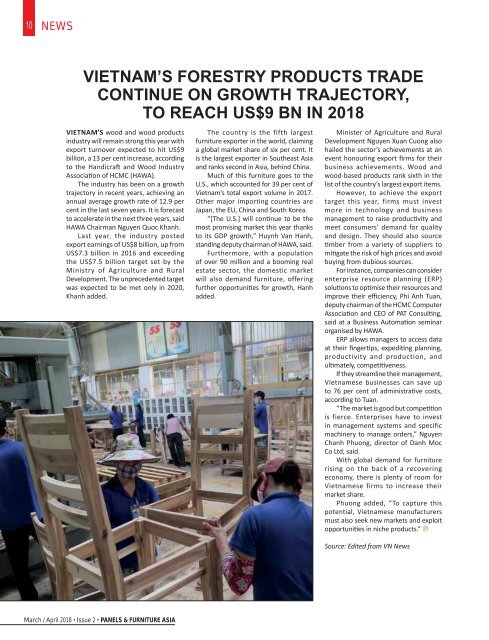Panels & Furniture Asia March/April 2018
Panels & Furniture Asia (PFA) is a leading regional trade magazine dedicated to the woodbased panel, furniture and flooring processing industry. Published bi-monthly since 2000, PFA delivers authentic journalism to cover the latest news, technology, machinery, projects, products and trade events throughout the sector. With a hardcopy and digital readership comprising manufacturers, designers and specifiers, among others, PFA is the platform of choice for connecting brands across the global woodworking landscape.
Panels & Furniture Asia (PFA) is a leading regional trade magazine dedicated to the woodbased panel, furniture and flooring processing industry. Published bi-monthly since 2000, PFA delivers authentic journalism to cover the latest news, technology, machinery, projects, products and trade events throughout the sector. With a hardcopy and digital readership comprising manufacturers, designers and specifiers, among others, PFA is the platform of choice for connecting brands across the global woodworking landscape.
You also want an ePaper? Increase the reach of your titles
YUMPU automatically turns print PDFs into web optimized ePapers that Google loves.
10 NEWS<br />
VIETNAM’S FORESTRY PRODUCTS TRADE<br />
CONTINUE ON GROWTH TRAJECTORY,<br />
TO REACH US$9 BN IN <strong>2018</strong><br />
VIETNAM’S wood and wood products<br />
industry will remain strong this year with<br />
export turnover expected to hit US$9<br />
billion, a 13 per cent increase, according<br />
to the Handicraft and Wood Industry<br />
Association of HCMC (HAWA).<br />
The industry has been on a growth<br />
trajectory in recent years, achieving an<br />
annual average growth rate of 12.9 per<br />
cent in the last seven years. It is forecast<br />
to accelerate in the next three years, said<br />
HAWA Chairman Nguyen Quoc Khanh.<br />
Last year, the industry posted<br />
export earnings of US$8 billion, up from<br />
US$7.3 billion in 2016 and exceeding<br />
the US$7.5 billion target set by the<br />
Ministry of Agriculture and Rural<br />
Development. The unprecedented target<br />
was expected to be met only in 2020,<br />
Khanh added.<br />
The country is the fifth largest<br />
furniture exporter in the world, claiming<br />
a global market share of six per cent. It<br />
is the largest exporter in Southeast <strong>Asia</strong><br />
and ranks second in <strong>Asia</strong>, behind China.<br />
Much of this furniture goes to the<br />
U.S., which accounted for 39 per cent of<br />
Vietnam’s total export volume in 2017.<br />
Other major importing countries are<br />
Japan, the EU, China and South Korea.<br />
“[The U.S.] will continue to be the<br />
most promising market this year thanks<br />
to its GDP growth,” Huynh Van Hanh,<br />
standing deputy chairman of HAWA, said.<br />
Furthermore, with a population<br />
of over 90 million and a booming real<br />
estate sector, the domestic market<br />
will also demand furniture, offering<br />
further opportunities for growth, Hanh<br />
added.<br />
Minister of Agriculture and Rural<br />
Development Nguyen Xuan Cuong also<br />
hailed the sector’s achievements at an<br />
event honouring export firms for their<br />
business achievements. Wood and<br />
wood-based products rank sixth in the<br />
list of the country’s largest export items.<br />
However, to achieve the export<br />
target this year, firms must invest<br />
more in technology and business<br />
management to raise productivity and<br />
meet consumers’ demand for quality<br />
and design. They should also source<br />
timber from a variety of suppliers to<br />
mitigate the risk of high prices and avoid<br />
buying from dubious sources.<br />
For instance, companies can consider<br />
enterprise resource planning (ERP)<br />
solutions to optimise their resources and<br />
improve their efficiency, Phi Anh Tuan,<br />
deputy chairman of the HCMC Computer<br />
Association and CEO of PAT Consulting,<br />
said at a Business Automation seminar<br />
organised by HAWA.<br />
ERP allows managers to access data<br />
at their fingertips, expediting planning,<br />
productivity and production, and<br />
ultimately, competitiveness.<br />
If they streamline their management,<br />
Vietnamese businesses can save up<br />
to 76 per cent of administrative costs,<br />
according to Tuan.<br />
“The market is good but competition<br />
is fierce. Enterprises have to invest<br />
in management systems and specific<br />
machinery to manage orders,” Nguyen<br />
Chanh Phuong, director of Danh Moc<br />
Co Ltd, said.<br />
With global demand for furniture<br />
rising on the back of a recovering<br />
economy, there is plenty of room for<br />
Vietnamese firms to increase their<br />
market share.<br />
Phuong added, “To capture this<br />
potential, Vietnamese manufacturers<br />
must also seek new markets and exploit<br />
opportunities in niche products.” ℗<br />
Source: Edited from VN News<br />
<strong>March</strong> / <strong>April</strong> <strong>2018</strong> • Issue 2 • PANELS & FURNITURE ASIA


















